
The Victoria and Albert Museum in London is the world's largest museum of applied arts, decorative arts and design, housing a permanent collection of over 2.27 million objects. It was founded in 1852 and named after Queen Victoria and Prince Albert.
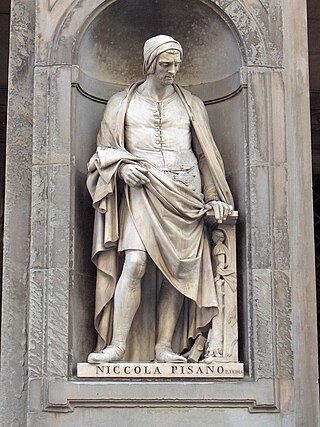
Nicola Pisano was an Italian sculptor whose work is noted for its classical Roman sculptural style. Pisano is sometimes considered to be the founder of modern sculpture.
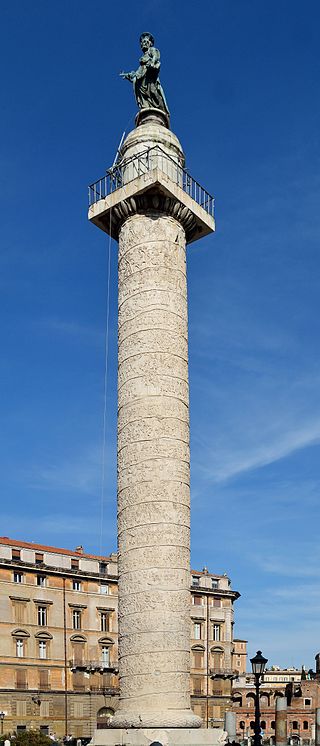
Trajan's Column is a Roman triumphal column in Rome, Italy, that commemorates Roman emperor Trajan's victory in the Dacian Wars. It was probably constructed under the supervision of the architect Apollodorus of Damascus at the order of the Roman Senate. It is located in Trajan's Forum, north of the Roman Forum. Completed in AD 113, the freestanding column is most famous for its spiral bas relief, which depicts the wars between the Romans and Dacians. Its design has inspired numerous victory columns, both ancient and modern.

The Raphael Cartoons are seven large cartoons for tapestries, surviving from a set of ten cartoons, designed by the High Renaissance painter Raphael in 1515–16, commissioned by Pope Leo X for the Sistine Chapel in the Vatican Palace. The tapestries show scenes from the Gospels and Acts of the Apostles and are hung below the frescoes of the Life of Christ and the Life of Moses commissioned by Pope Sextus. The cartoons belong to the British Royal Collection but since 1865 are on loan to the Victoria and Albert Museum in London.
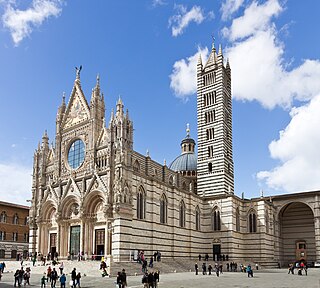
Siena Cathedral is a medieval church in Siena, Italy, dedicated from its earliest days as a Roman Catholic Marian church, and now dedicated to the Assumption of Mary.

The Piazza dei Miracoli, formally known as Piazza del Duomo, is a walled 8.87-hectare (21.9-acre) area located in Pisa, Tuscany, Italy, recognized as an important center of European medieval art and one of the finest architectural complexes in the world. Considered sacred by the Catholic Church, its owner, the square is dominated by four great religious edifices: the Pisa Cathedral, the Pisa Baptistery, the Campanile, and the Camposanto Monumentale. Partly paved and partly grassed, the Piazza dei Miracoli is also the site of the Ospedale Nuovo di Santo Spirito, which houses the Sinopias Museum and the Cathedral Museum.
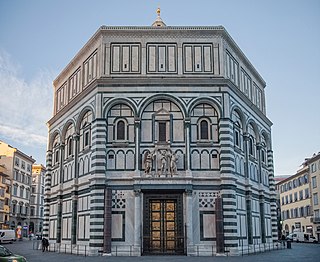
The Florence Baptistery, also known as the Baptistery of Saint John, is a religious building in Florence, Italy, and has the status of a minor basilica. The octagonal baptistery stands in both the Piazza del Duomo and the Piazza San Giovanni, across from Florence Cathedral and the Campanile di Giotto.

Saint Isaac's Cathedral or Isaakievskiy Sobor is a large architectural landmark cathedral that currently functions as a museum with occasional church services in Saint Petersburg, Russia. It is dedicated to Saint Isaac of Dalmatia, a patron saint of Peter the Great, who had been born on the feast day of that saint. It was originally built as a cathedral but was turned into a museum by the Soviet government in 1931 and has remained a museum ever since, with church services held in a side chapel since the 1990s. In 2017, the Governor of Saint Petersburg offered to transfer the cathedral back to the Russian Orthodox Church, but this was not accomplished due to the protests of St Petersburg citizens opposing the offer.

The Burghers of Calais is a sculpture by Auguste Rodin in twelve original castings and numerous copies. It commemorates an event during the Hundred Years' War, when Calais, a French port on the English Channel, surrendered to the English after an eleven-month siege. The city commissioned Rodin to create the sculpture in 1884 and the work was completed in 1889.
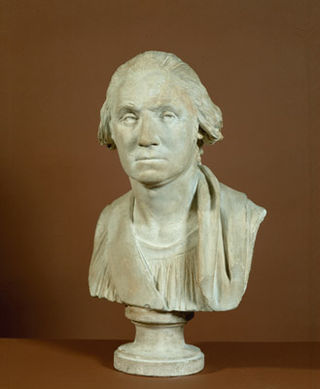
A plaster cast is a copy made in plaster of another 3-dimensional form. The original from which the cast is taken may be a sculpture, building, a face, a pregnant belly, a fossil or other remains such as fresh or fossilised footprints – particularly in palaeontology.
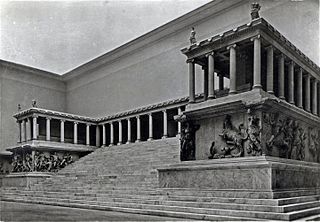
The Pergamon Altar was a monumental construction built during the reign of the Ancient Greek King Eumenes II in the first half of the 2nd century BC on one of the terraces of the acropolis of Pergamon in Asia Minor.

The Altes Museum is a listed building on the Museum Island in the historic centre of Berlin, Germany. Built from 1825 to 1830 by order of King Frederick William III of Prussia according to plans by Karl Friedrich Schinkel, it is considered as a major work of German Neoclassical architecture. It is surrounded by the Berlin Cathedral to the east, the Berlin Palace to the south and the Zeughaus to the west. Currently, the Altes Museum is home to the Antikensammlung and parts of the Münzkabinett. As part of the Museum Island complex, the Altes Museum was listed as a UNESCO World Heritage Site in 1999, because of its testimony to the development of museums as a social and architectural phenomenon.
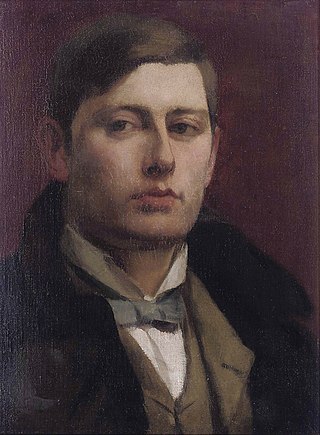
Sir George James Frampton, was a British sculptor. He was a leading member of the New Sculpture movement in his early career when he created sculptures with elements of Art Nouveau and Symbolism, often combining different materials such as marble and bronze in a single piece. While his later works were more traditional in style, Frampton had a prolific career in which he created many notable public monuments, including several statues of Queen Victoria and later, after World War I, a number of war memorials. These included the Edith Cavell Memorial in London, which, along with the Peter Pan statue in Kensington Gardens are possibly Frampton's best known works.
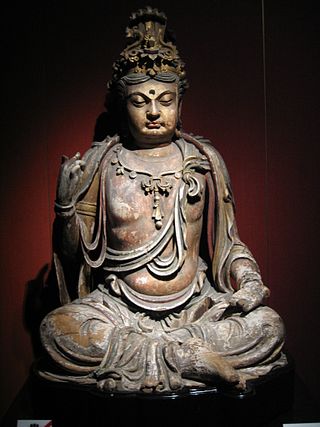
Wood carving is one of the oldest arts of humankind. Wooden spears from the Middle Paleolithic, such as the Clacton Spear, reveal how humans have engaged in utilitarian woodwork for millennia. However, given the relatively rapid rate at which wood decays in most environments, there are only isolated ancient artifacts remaining.

Pisa Cathedral is a medieval Roman Catholic cathedral dedicated to the Assumption of the Virgin Mary, in the Piazza dei Miracoli in Pisa, Italy, the oldest of the three structures in the plaza followed by the Pisa Baptistry and the Campanile known as the Leaning Tower of Pisa. The cathedral is a notable example of Romanesque architecture, in particular the style known as Pisan Romanesque. Consecrated in 1118, it is the seat of the Archbishop of Pisa. Construction began in 1063 and was completed in 1092. Additional enlargements and a new facade were built in the 12th century and the roof was replaced after damage from a fire in 1595.
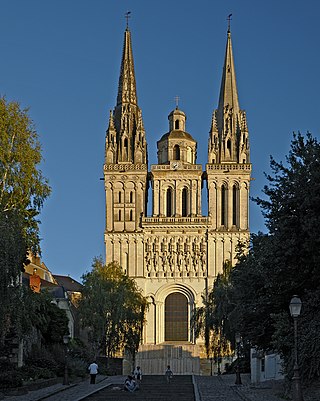
Angers Cathedral is a Roman Catholic church dedicated to Saint Maurice in Angers, France. It is the seat of the Bishops of Angers.

The Victoria Art Gallery is a public art museum in Bath, Somerset, England. It was opened in 1900 to commemorate the Diamond Jubilee of Queen Victoria. It is a Grade II* listed building and houses over 1,500 objects of art including a collection of oil paintings from British artists dating from 1700 onwards. The ground floor was at one time a public library.

The Harris Museum is a Grade I-listed building in Preston, Lancashire, England. Founded by Edmund Harris in 1877, it is a local history and fine art museum.

Richard Cockle Lucas was a British sculptor and photographer.

The Siena Cathedral Pulpit is an octagonal structure in Siena Cathedral sculpted by Nicola Pisano and his assistants Arnolfo di Cambio, Lapo di Ricevuto, and Nicolas' son Giovanni Pisano between the fall of 1265 and the fall of 1268. The pulpit, with its seven narrative panels and nine decorative columns carved out of Carrara marble, showcases Nicola Pisano's talent for integrating classical themes into Christian traditions, making both Nicola Pisano and the Siena pulpit forerunners of the classical revival of the Italian Renaissance.






























